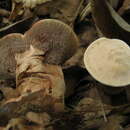Biology
provided by Arkive
Fungi are neither plants nor animals but belong to their own kingdom. They are unable to produce their own food through the process of photosynthesis, as plants do; instead, they acquire nutrients from living or dead plants, animals, or other fungi, as animals do. In many larger fungi (lichens excepted) the only visible parts are the fruit bodies, which arise from a largely unseen network of threads called 'hyphae'. These hyphae permeate the fungus's food source, which may be soil, leaf litter, rotten wood, dung, and so on, depending on the species. With the exception of the earpick fungus Auriscalpium vulgare, all stipitate hydnoid fungi are ectomycorrhizal species; they form close symbiotic relationships with trees, and derive some of their nutrients from the tree's roots. This aids them in obtaining nutrients on poor quality soil, and means that are always found in association with trees (1).
Hydnellum spongiosipes is associated with oak, sweet chestnut, and less frequently beech, alder, birch and hawthorn; this provides an easy, but not necessarily accurate way of distinguishing between this species and H. ferrugineum, which occurs mainly under pine (1).
The best time of year to look for the fruit bodies of Hydnellum species is September. Interestingly, all Hydnellum species show very low levels of invertebrate damage; it is possible that they may contain protective chemicals that may also protect them from grazing mammals (1).
Conservation
provided by Arkive
The UK Biodiversity Action Plan (UK BAP) has produced a Group Action Plan for 14 UK species of stipitate hydnoid fungi (2). Much more research on these fungi is needed if they are to be conserved (1). Scottish Natural Heritage has been conducting an extensive survey of all stipitate hydnoid fungi in Scotland (4). Velvet tooth fungus is afforded general protection under the Wildlife and Countryside Act 1981, but it is not one of the four species of non-lichenized fungi given special protection under Schedule 8 (2).
Description
provided by Arkive
The velvet tooth fungus belongs to the stipitate hydnoid fungi group. These are a group of 'tooth fungi' (fungi that release their spores from tooth-like structures), which have a short stalk or 'stipe', hence the name 'stipitate' (6). Young fruit bodies of Hydnellum spongiosipes have different colours to older ones, as the pale area of growth is broadest in young specimens (4). As they age, the fruit bodies become purple-brown without ridged 'growth zones' (4). Several caps often fuse into one mass, which has a number of stalks, and may grow around blades of grass and other objects (4). This fungus has a downy stipe and lumpy cap (4), and is very similar in appearance to the related species, Hydnellum ferrugineum, but is said to have less distinct zonation of the cap and is darker (4).
WARNING: many species of fungus are poisonous or contain chemicals that can cause sickness. Never pick and eat any species of fungus that you cannot positively recognise or are unsure about. Some species are deadly poisonous and can cause death within a few hours if swallowed.
Habitat
provided by Arkive
Occurs in well-established (1) broadleaved woodlands, particularly oak (4), and is commonly found on stream banks, marl pits and banks with either bare or moss-covered ground, in acidic sandy soil, alkaline clays, and limestone (1).
Range
provided by Arkive
This species has a wide distribution in Europe and North America. In the British Isles, where it is found it is local (4). In England, records are concentrated in the south, particularly the New Forest (9), but it has also been recorded from East Norfolk, southeast Yorkshire, and the Wye Valley (1). There is one recent Welsh record (7), one recent Scottish record (8), and it is also known from Ireland. It is perhaps our third most common species of stipitate hydnoid fungi, but is endangered in the west of Germany and the Netherlands following a precipitous decline (1).
Status
provided by Arkive
Provisionally classified as Vulnerable in Great Britain (2). Digging up fungi without permission could also constitute theft under the Theft Act of 1968 (3).
Threats
provided by Arkive
All species of stipitate hydnoid fungi are vulnerable to the effects of atmospheric pollution (1), soil eutrophication, soil disturbance (eg by timber management) and competition from vascular plants (1).
Associations
provided by BioImages, the virtual fieldguide, UK
Foodplant / mycorrhiza / ectomycorrhiza
fruitbody of Hydnellum spongiosipes is ectomycorrhizal with live root of Ectomycorrhizal broadleaved trees and shrubs
Remarks: Other: uncertain
Foodplant / mycorrhiza / ectomycorrhiza
fruitbody of Hydnellum spongiosipes is ectomycorrhizal with live root of Quercus
Remarks: Other: uncertain
Other: major host/prey
Foodplant / mycorrhiza / ectomycorrhiza
fruitbody of Hydnellum spongiosipes is ectomycorrhizal with live root of Betula
Remarks: Other: uncertain
Other: minor host/prey
Foodplant / mycorrhiza / ectomycorrhiza
fruitbody of Hydnellum spongiosipes is ectomycorrhizal with live root of Castanea sativa
Remarks: Other: uncertain
Other: minor host/prey
Foodplant / mycorrhiza / ectomycorrhiza
fruitbody of Hydnellum spongiosipes is ectomycorrhizal with live root of Fagus
Remarks: Other: uncertain
Other: minor host/prey

